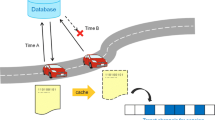Abstract
This paper presents design and experimental evaluation of a distributed autonomous multi-hop vehicle-to-vehicle (V2V) communication system over TV white space performed in Japan. We propose the two-layer control channel model, which consists of the Zone Aware Control Channel (ZACC) and the Swarm Aware Control Channel (SACC), to establish the multi-hop network. Several vehicles construct a swarm using location information shared through ZACC, and share route and channel information, and available white space information through SACC. To evaluate the system we carried out field experiments with swarm made of three vehicles in a convoy. The vehicles observe channel occupancy via energy detection and agree on the control and the data channels autonomously. For coarse synchronization of quiet periods for sensing we use GPS driven oscillators, and introduce a time margin to accommodate for remaining drift. When a primary user is detected in any of the borrowed channels, the vehicles switch to a vacant channel without disrupting the ongoing multi-hop communication. We present the experimental results in terms of the time to establish control channel, channel switching time, delivery ratio of control message exchange, and throughput. As a result, we showed that our implementation can provide efficient and stable multi-hop V2V communication by using dynamic spectrum access (DSA) techniques.















Similar content being viewed by others
Notes
Moving speed and direction of each node can be calculated based on the information obtained from multiple (> two) consecutive messages.
Dynamic treatment of vehicle join/leave is out of scope of this paper.
Both “node location” and “list of available channels” are also treated as the routing information, in addition to those for traditional protocols.
References
Hassan MI, Vu HL, Sakurai T (2011) Performance analysis of the IEEE 802.11 MAC protocol for DSRC safety applications. IEEE Trans Veh Technol 60(8):3882–3896
Ma X, Chen X and Refai HH (2009) Performance and reliability of DSRC vehicular safety communication: a formal analysis,. EURASIP J Wirel Commun Netw, Article 3:13 pages
Kremo H, Vuyyuru R and Altintas O (2012) spectrum sensing in the vehicular environment: an overview of the requirements. Proc. of SDR’12-WInnComm-Europe
Mitola J III (1999) Cognitive radio for flexible mobile multimedia communications, in Proc. of IEEE International Workshop on Mobile Multimedia. Communications 1:3–10
Haykin S (2005) Cognitive radio: Brain-empowered wireless communications. IEEE J Sel Areas Commun 23:201–220
(2011) IEEE standard for information technology–Telecommunications and information exchange between systems Wireless Regional Area Networks (WRAN) –Specific requirements Part 22: Cognitive Wireless RAN Medium Access Control (MAC) and Physical Layer (PHY) Specifications: Policies and Procedures for Operation in the TV Bands. IEEE Std 802.22-2011:1-680
Tsukamoto K, Matsuoka S, Altintas O, Tsuru M, Oie Y (2008) Distributed channel coordination in cognitive wireless vehicle-to-vehicle communications. Proc. of WAVE, CD-ROM
Tsukamoto K, Omori Y, Altintas O, Tsuru M, Oie Y (2009) On spatially-aware channel selection in dynamic spectrum access multi-hop inter-vehicle communications. Proc. of IEEE VTC-fall, CD-ROM
Altintas O, Nishibori M, Takuro O, Ihara Y, Saito M, Vuyyuru R, Yoshimura C, Fujii Y, Nishida K, Tsukamoto K, Tsuru M, Oie Y, Abbasi AA, Ohtake M, Ohta M, Fujii T, Chen S, Pagadarai S and Wyglinski AM (2011) Demonstration of vehicle to vehicle communications over TV white space. Proc. of IEEE WiVeC, CD-ROM
Altintas O et al (2013) Field tests and indoor emulation of distributed autonomous multi-hop vehicle-to-vehicle communications over TV white space. Proc ACM SIGMOBILE Mob Comput and Commun Rev 16(4):54–57
Ettus Research (2012) USRP N200/N210 Networked Series. Ettus Research, Mountain View
GNU Radio Project Website, http://www.gnuradio.org
Kay S (2011) Fundamentals of statistical signal processing – detection theory. Prentice Hall
Wang C-L, Chen H-W, Tsai Z-Y (2012) Throughput Maximization for Cognitive Radio Networks with Wideband Spectrum Sensing. Proc. of IEEE WCNC:1293–1298
Liang Y-C, Zeng Y, Peh ECY, Hoang AT (2008) Sensing-throughput tradeoff for cognitive radio networks. IEEE Trans Wirel Commun 7(4):1326–1337
(2010) Second Memorandum Opinion and Order in the Matter of Unlicensed Operation in the TV Broadcast Bands, Additional Spectrum for Unlicensed Devices Below 900 MHz and in the 3 GHz Band. Federal Communications Commission
Iperf network testing tool, http://iperf.sourceforge.net/
Author information
Authors and Affiliations
Corresponding author
Rights and permissions
About this article
Cite this article
Tsukamoto, K., Oie, Y., Kremo, H. et al. Implementation and Performance Evaluation of Distributed Autonomous Multi-Hop Vehicle-to-Vehicle Communications over TV White Space. Mobile Netw Appl 20, 203–219 (2015). https://doi.org/10.1007/s11036-015-0576-5
Published:
Issue Date:
DOI: https://doi.org/10.1007/s11036-015-0576-5




